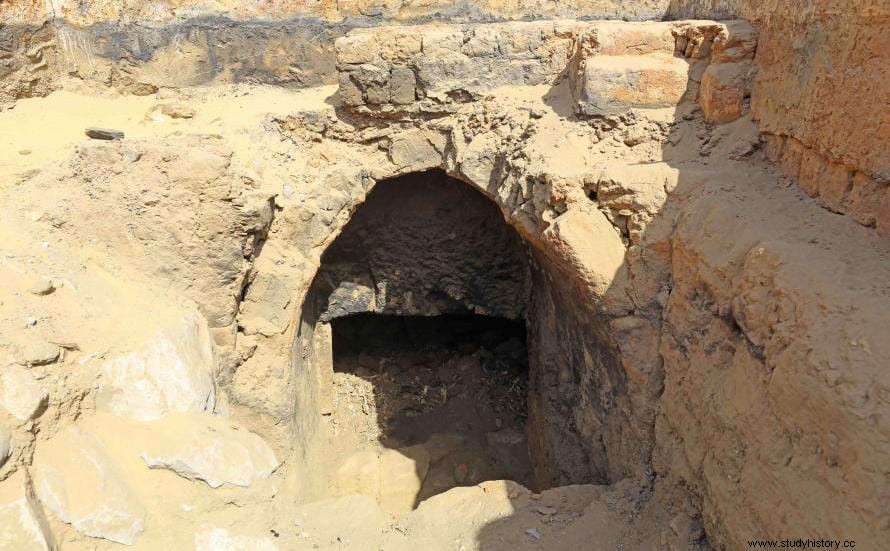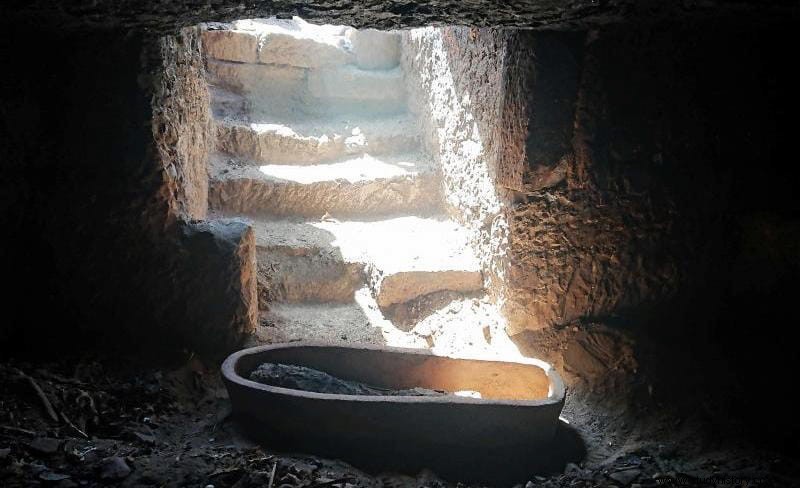The Italo-Egyptian Mission in Western Aswan (EIMAWA) led by Patrizia Piacentini, Professor of Egyptology and Egyptian Archeology at Milan State University, and Abdelmoneim Said, Director General of Aswan and Nubian Antiquities (SCA), has discovered and excavated a large and hitherto unknown family tomb. The discovery was made during a long mission in which archaeologists participated between May and October 2021.
The joint Italian-Egyptian team has been working since 2019 around the Aga Khan Mausoleum, on the west bank of Aswan, where there are more than 300 tombs dating back to the 6th century BC. to the 4th century AD
The latest find is a large tomb (named AGH032) dating from the Greco-Roman era, which, although looted in ancient times, contains around 20 mummies and many interesting materials. The tomb was hidden by a well-preserved rectangular structure that shows significant traces of a mysterious fire that also affected the burial.

A huge dump containing animal bones (mostly lamb), pottery shards, offering plates, and hieroglyphic inscribed slabs covered the eastern wall of the structure, suggesting its use as a place of worship. It is the first structure of this type found in the Aga Khan necropolis.
Specifically, the archaeologists found the mummy of a man next to the east wall of the structure and, next to it, a copper necklace with a plaque engraved in Greek that mentioned his name, Nikostratos. Originally, it had been deposited in the tomb that was discovered shortly after under the structure and subsequently looted by ancient thieves.

A stairway partially flanked by carved blocks and covered by an adobe vault leads to the entrance, which was closed by a complex system of stone slabs and blocks found on the original site that had risen above the stairway. In front of the entrance, a large offering vessel was found, unfortunately in a fragmentary state, which still contains the sycamore pods.
The tomb has a vestibule with four funerary chambers carved into the rock. In the vestibule, in front of the entrance, a clay sarcophagus was discovered containing the mummy of a child and a beautiful cardboard (kind of decorated papier-mâché that covered the mummies). Another mummy of a child, found in one of the burial chambers, has been X-rayed and shows a plaque inside the chest.
Inside the four rock-cut galleries there were almost 30 mummies, some in an exceptional state of preservation, others with bandages and cardboard cut by ancient thieves, who probably used a knife that was discovered among the mummies. Some mummified bodies were of elderly people, as evidenced by visible osteoarthritis, others were of women or small children, including a baby.

The Egyptian-Italian Mission in West Aswan also carried out anthropological and radiological analyzes of 45 individuals discovered in 2019 in tomb AGH026, in addition to the 30 individuals found in 2021 in tomb AGH032. The objective was to assess age, sex and possible diseases. A portable X-ray machine was used directly on site.
The team found that in tomb AGH026 30% of the individuals were children, from the neonatal period to an age of about 10 years. Many of the remaining bodies were of women. At least three families were found (mother, father and son buried next to each other). Bone analyzes showed that some of them suffered from infectious diseases and some metabolic disorders. The femur of an adult showed clear signs of amputation, which the person had to survive, as there is evidence of an osteo-repairing callus. Other bodies show evidence of osteoarthritis, a sign of death in old age.
A survey of the area revealed several well-preserved sarcophagi, made of stone or clay, dating from the late Pharaonic to Roman times. Some of them still show beautiful colors. Two children's and three adult sarcophagi were collected, along with parts of other sarcophagi, and placed in storage.
